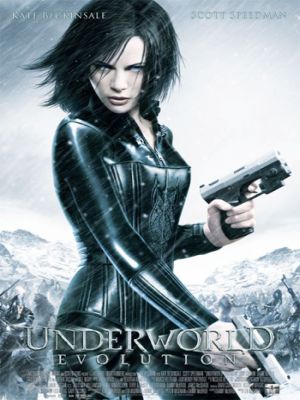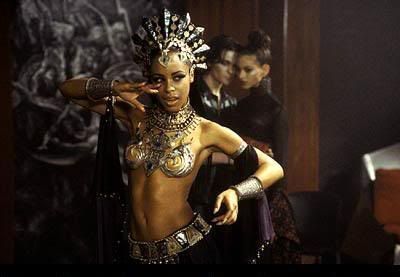When the Count saw my face, his eyes blazed with a sort of demonic fury, and he suddenly made a grab at my throat. I drew away, and his hand touched the string of beads which held the crucifix. It made an instant change in him, for the fury passed so quickly that I could hardly believe that it was ever there. - Bram Stoker's DraculaI read page after page getting with growing fear until--I shut it. I buried Dracula behind a stack of other books on my shelf, with the spine facing in and the cover hidden. I spent the rest of the night huddled under blankets awaiting the return of my roommate. I haven't opened the book since. He's still at the back of my bookshelf, breathing, waiting. Maybe I'll never know the fates of Jonathan Harker, Lucy or Mina. Logic and science tells me that vampires don't exist, but still--I'm not sure I can ever face him.
Throughout history, society has created monsters to explain the mysteries of the world--mysteries that science had not yet made clear to them. Ghosts, sea monsters, aliens, zombies, and of course, no monster has experienced as much fame as the vampire.

Precursors to modern vampires can be seen in Mesopotamian, Hebrew, and Ancient Greek cultures, to name a few. Early belief in vampires has been blamed on ignorance of the body's process of decomposition after death and how people rationalized it. When a community was plagued by a mysterious illness or unexplained livestock deaths, a vampire explained the mystery without the necessity of science.
Vampires During The Age Of Enlightenment
During the 18th Century, vampire hysterics was a huge problem in Europe. Rural epidemics and unexplained livestock death fostered vampire superstition. So scared were people that they would dig up interred bodies to stake them. In 1764, Age of Enlightenment philosopher, Voltaire, wrote in his Philosophical Dictionary:
'These vampires were corpses, who went out of their graves at night to suck the blood of the living, either at their throats or stomachs, after which they returned to their cemeteries. The persons so sucked waned, grew pale, and fell into consumption; while the sucking corpses grewMany scholars of the period reported that vampires did not exist, attributing reports to premature burial or rabies. Tuberculosis and the pneumonic form of bubonic plague could have explained bloody mouths because both are associated with breakdown of lung tissue. Despite scholarly assertions, vampiric belief increased. Such was the hysteria that Empress Maria Theresa of Austria sent her physician, Gerhard van Swieten, to investigate vampire claims. When Swieten concluded that vampires did not exist, she prohibited the desecration of graves. Although this ended vampire epidemics, the creature lives on in superstition and artistic works.
fat, got rosy, and enjoyed an excellent appetite. It was in Poland, Hungary, Silesia, Moravia, Austria, and Lorraine, that the dead made this good cheer.'
The hypnotizing, sophisticated and sexy vampire of today was first born in 1819, when John Polidori wrote, The Vampyre. But it was Bram Stoker's novel, Dracula, in 1897, which really provided the basis of the modern vampire legend.

Vlad III (Prince of Wallachia 1431-1476) is known for inspiring the name of the vampire in Bram Stoker's novel. He went by several names, including Vlad Dracula, Dracula and 'Vlad the Impaler,' due to sadistic punishments imposed during his reign. Impalement was his preferred method of torture and execution. The number of his victims ranges from 40,000 to 100,000, although many stories about him have been fictional or exaggerated.

(Woodblock print of Vlad III 'Dracula' attending a mass impalement)
Bram Stoker's Dracula spawned a new vampire genre, still popular today. Although pre-Stoker folkloric vampires were described as being bloated and rosy from sucking blood, the Stoker-inspired vampire is typically pale, thin and seductive.
'The fair girl went on her knees and bent over me, fairly gloating. There was a deliberate voluptuousness which was both thrilling and repulsive, and as she arched her neck she actually licked her lips like an animal... I could feel the soft, shivering touch of the lips on the supersensitive skin of my throat, and the hard dents of two sharp teeth, just touching and pausing there.'Vampires of Today– Bram Stoker’s Dracula
Although vampire’s are generally viewed to be fictitious, vampire-like creatures still persist all over the world. Supernatural beings drinking blood or flesh can be found in nearly every culture. In India, vetalas are ghoul-like beings that inhabit corpses. In Philippine mythology, there is a vampire-like creature called an aswang who walks amongst everyday people, typically in a position that requires bloody work, like that of a butcher or surgeon. During certain times of the month, the aswang sheds his lower torso, grows wings and unfurls a long tongue used to suck the unborn fetus from a pregnant woman via the belly button. The chupacabra is a mythological vampire-like creature known in the Americas, particularly Latin America, and drinks the blood of livestock.
Nowadays, vampires look more ‘emo’ than scary. They wear trench coats, sport sexy smiles and have a long lock of hair partially obscuring a hypnotizing eye. Today’s Hollywood vampires are the perfect embodiment of our modern day antihero—they are outcast from society, sexually appealing and equipped with superhero qualities such as immortality, the ability to transform into animals, to fly, etc. Today, many of our vampires are embodied with human likenesses: kind hearts, consciences and the ability to love. Vampire believers of old might laugh at our modern representations of the vampire, but I gotta say, they make for some sexy story lines!--And so, because I just can't resist, here is my list of
Hollywood's Top 10 Recent Sexy Vampires:
(Be forewarned, some of these images are quite suggestive.)
10. David Boreanaz as ‘Angel’ in Angel (1999)
Angel, a hybrid of man and vampire, battles evil demons while his vampire urges and human conscience are constantly at odds. His sexy hairstyle and heart melted the heart of Sarah Michelle Gellar as 'Buffy'in the Buffy the Vampire Slayer television series, where his character was first seen.

Evidence of a vampire in a given locality included death of cattle, sheep and members of the community. Angel tries to feed on animals, not people. I can't account for the neighbors though.
9. Wesley Snipes as ‘Blade’ in Blade (1998)
Blade is loosely based on the published stories of the fictional Marvel Comics character Blade. Like Angel, Blade is a half-man, half-vampire who hunts vampires as the protector of humans. Blade’s sexy sunglasses and pre-Matrix trench coat signify vampire butt-kicking abilities and the penchant for partying.

8. Kate Beckinsale as 'Selene' in Underworld (2003)
Selene is the leader of a vampire group attempting to fend off the Lycans. Like Blade, the Underworld films are filled with action packed vampire butt-kicking by Kate in skin-tight black that leaves just enough to the imagination. Also, there's just something about her icy blue eyes that say, "Take me, take me!"

witches, suicide victims, or people who had rebelled against the Church
while they were alive. Kate sure looks like she's been a bad girl to me.
7. Jason Patric as 'Michael Emerson' in The Lost Boys (1987)
Jason Patric almost becomes a vampire in The Lost Boys when he is tricked into drinking human blood. Thankfully, he's saved by his brother Sam and his group of amateur vampire-hunter friends. In the movie, the town of Santa Carla, California is plagued with gangs and disappearances. Honorable mention: Kiefer Sutherland as David. Kiefer's hairstyle in this movie reminds me of when he played the also creepy 'Ace' in Stand By Me. I can't be helped but be impressed by his ability to be pathologically creepy and yet sexy at the same time. This movie's soundtrack is extra creepy with choirs of singing children, so for those faint of heart, who just want to drool over Patric, I suggest the mute button.

plays a naive high school student seduced by a vampire.
6. Aaliyah as 'Akasha' in Queen of the Damned (2002)
Despite the sad confession that this movie was so awful that I actually walked out of it, even I cannot deny Akasha’s sexy dance movies. The slow gyrations of her hips are hypnotic and heartstopping—literally. The Queen of the Damned film is based on the third novel of Anne Rice's The Vampire Chronicles series. It was released six months after Aaliyah's death in a plane crash and is dedicated to her memory.

starring Sarah Michelle Gellar. It had a run of seven seasons, for a
total of 144 episodes.
5. Antonio Banderas as 'Armand' in Interview with the Vampire (1994)
I enjoy Antonio's accent every day of the week, but there's something about the fangs and the cape that make him go up, up, up on the hot-meter! Tom Cruise is not on this list because of that one really disturbing scene when Kirsten Dunst tricks Tom Cruise into drinking blood from a dead body. He looks totally disgusting.

described as having a healthier appearance than expected, plump and
showing little or no signs of decomposition. Antonio looks pretty healthy to me!
4. Salma Hayek as ‘Santanico Pandemonium’ in From Dusk Till Dawn (1996)
Santanico Pandemonium is a vampire queen who is introduced as “the mistress of the macabre.” She performs a sultry dance with a snake coiled around her neck and drops it like she’s on fire. Note: Selma Hayek beats Aaliyah on this list because Hayek refrains from eating someone’s heart. Gross.

3. Brad Pitt as 'Louis' in Interview with the Vampire (1994)
Brad Pitt’s lengthy locks, reminiscent of his A River Runs Through It days, are sure to stir every girl’s heart. His unwillingness to feed on Christian Slater, his interviewer, while he tells his life story is indicative of his thoughtful and self-sacrificing nature.
As a side note: Brad Pitt is now with Angelina Jolie, who used to wear a vial of her ex Billy Bob Thornton’s blood around her neck.

2. Robert Pattinson as 'Edward Cullen' in Twilight (2008)
Twilight follows the story of a seventeen-year-old girl who falls in love with the vampire, Edward Cullen. I am certain that having Robert Pattinson on this list breaks all sorts of rules because I haven't seen the movie yet, and really, Twilight isn't in theatres until November 21, 2008.
Stephanie Meyer's Twilight series is taking the world by storm, and Pattinson is the same heartthrob who played "Cedric Diggory" in the film adaptation of JK Rowling's Harry Potter and the Goblet of Fire. For that, he wins my vote completely. In a bizarre coincidence, in an issue of Time, Stephanie Meyer, was recently called the “new J.K. Rowling.”

was based on Richard Matheson's 1954 sci-fi vampire novel. The film
grossed over $584 million at the box office.
1. The top spot is up for grabs. Who do you think deserves to be number one?




Comments